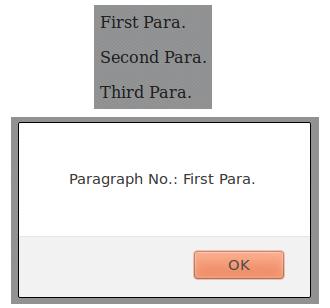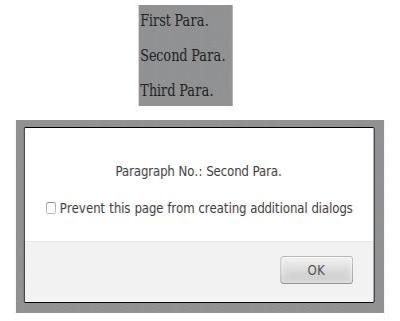| Building blocks of $() | Description |
|---|---|
| Tag Name | Represents a tag name available in DOM. Example: $('p') will select all the paragraphs in the document. |
| Tag ID | Represents a tag ID available in DOM. Example: $('#my-id') will select the single element in the document that has an ID of my-id. |
| Tag Class | Represents a tag class available in DOM. Example: $('.my-class') will select all the elements in the html document that has a class of my-class. |
| Universal | Selects all elements available in DOM. |
| Multiple Elements A,B,C | Selects all the combined results of all the specified selectors A,B,C. |
<html>
<head>
<title> The Example </title>
<script type="text/javascript" src="https://ajax.googleapis.com/ajax/libs/jquery/1.12.2/jquery.min.js"> </script>
<script type="text/javascript" language ="javascript">
$(document).ready(function()
{
var para =$("p"); //tag name
for(i=0; i<para.length; i++)
{
alert("Paragraph No: " +para[i].innerHTML);
}
});
</script>
</head>
<body>
<div>
<p class="myclass">First Para. </p><!--tag class-->
<p id="myid">Second Para </p> <!--tag id-->
<p> Third Para. </p> <!--tag name-->
</div>
</body>
</html>


| Types | Description |
|---|---|
| $(“*”) | Selects all elements. |
| $(“p”) | Selects all the <p> paragraph elements. |
| $(“p>*”) | Selects all the elements that are children of <p> element. |
| $(“.myclass”) | Selects all elements with class= “myclass”. |
| $(“p.myclass”) | Selects all paragraph <p> elements with class= “myclass”. |
| $(“p:not(.myclass)”) | Selects all the <p> elements that do not have a class= “myclass”. |
| $(“p#myID.myclass”) | This selector matches the paragraphs with an id of myID and a class of myClass. |
| $(“:empty”) | Selects all the elements that have no children. |
| $(“p:empty”) | Selects all <p> elements that have no children. |
| $(“:animated”) | Selects all the elements that are animated currently. |
| $(“:button”) | Selects all <button> and <input> elements of type=“button”. |
| $(“:even”) | Selects all the even elements. |
| $(“li:even”) | Selects all <li> elements that have an even index value. |
| $(“:odd”) | Selects all the odd elements. |
| $(“p:visible”) | Selects all the <p> elements that are visible. |
| $(“p:hidden”) | Selects all the <p> elements that are hidden. |
| $(this) | Selects the current HTML element. |
| $(“div[p]”) | Selects all the elements matched by <div> that contain an element matched by <p>. |
| $(“p:first”) | Selects the first <p> element. |
| $(“p#myID:first”) | Selects the first <p> element with id= “myID”. |
| $(“#myID”) | Selects the first element with id= “myID”. |
| $(“ul li:first-child”) | Selects the first <li> element of every <ul>. |
| $(“[href]”) | Selects all the elements with the href attribute. |
| $(“a[@rel]”) | Selects all the elements matched by <a> that have a 'rel' attribute. |
| $(“input[@name=txtname]”) | Selects all the elements matched by the <input> tag that have a name value exactly equal to the txtname. |
| $(“input[@name^=txt]”) | Selects all the elements matched by the <input> tag that have a name value beginning with txt. |
| $(“[href='abc.asp]”) | Selects all elements with an href value equal to “abc.asp”. |
| $(“[href!='abc.asp]”) | Selects all elements with an href value NOT equal to “abc.asp”. |
| $(“div#myID.head”) | Selects all elements with class = “head” inside a <div> element with id = “myID”. |